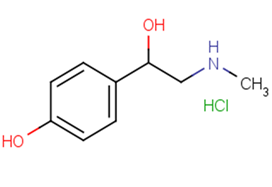Powder: -20°C for 3 years | In solvent: -80°C for 1 year


Synephrine hydrochloride (Oxedrine hydrochloride) is an agonist that acts on sympathomimetic α-adrenergic receptor (AR).

| Pack Size | Availability | Price/USD | Quantity |
|---|---|---|---|
| 1 g | In stock | $ 29.00 | |
| 1 mL * 10 mM (in DMSO) | In stock | $ 29.00 |



| Description | Synephrine hydrochloride (Oxedrine hydrochloride) is an agonist that acts on sympathomimetic α-adrenergic receptor (AR). |
| In vitro | Synephrine (0.1-30 μM) displays potent vasoconstrictive effects on isolated rat aorta in a dose dependent manner, which can be significantly inhibited by pretreatment with prazosin, BRL15572, and ketanserin but not by pretreatment with SB216641 and propranolol, indicating that Synephrine exerts the constrictive effects via adrenergic alpha(1)-receptors, serotonergic 5-HT(1D) receptors, and 5-HT(2A) receptors. [2] Although the Ki values of Synephrine, 1R,2S-norephedrine, and β-phenethylamine are same for all three subtypes, only Synephrine is a partial agonist of α1A-AR subtype stably expressed in HEK 293 cells with EC50 of 4 μM, giving a maximal response at 100 μM that is equal to 55.3 % of the L-phenylephrine maximum. Functional studies on the α2A- and α2C-AR subtypes stably expressed in CHO cells indicate that Synephrine may act as an antagonist rather than an agonist of the pre-synaptic α(2A)- and α(2C)-AR subtypes present in nerve terminals, although antagonist activity of synephrine is lower than its partial agonist potency. [3] Synephrine (~100 μM) treatment increases basal glucose consumption up to 50% over the control in a dose-dependent manner, without affecting the viability of L6 skeletal muscle cells. Synephrine significantly stimulates the basal- or insulin-stimulated lactic acid production as well as glucose consumption. Synephrine treatment stimulates the phosphorylation of AMPK but not Akt, and Synephrine-induced glucose consumption and the translocation of Glut4 from the cytoplasm to the plasma membrane are sensitive to the inhibition of AMPK but not to the inhibition of PI3 kinase. [4] |
| In vivo | Administration of Synephrine (1 mg/kg per 12 hours) for 8 days significantly improves the hyperdynamic state in portal hypertensive rats induced by either partial portal vein ligation (PVL) or bile duct ligation (BDL), and significantly reduces the portal venous pressure, portal tributary blood flow and cardiac index in both PVL and BDL rats. [1] |
| Kinase Assay | In vitro kinase assays [1] : To screen for small molecule inhibitors of ATM kinase activity, an in vitro kinase assay is adapted, and an ELISA assay develops which measured the phosphorylation status of the ATM downstream target p53. Recombinant GST-p53(1-101) and full-length Flag-tagged ATM & ATR are purified for use in the ELISA and in vitro kinase assays. Briefly, Nunc 96 well Maxisorp plates are coated overnight (4 °C) with 2μg of purified, recombinant GST-p53(1-101) in PBS. All subsequent incubations are performed at room temperature. The plates are washed (0.05%v/v-Tween/PBS) before addition of purified recombinant full-length ATM kinase (30 ng–60 ng) in a final volume of 80μL of reaction buffer (20 mM HEPES, 50 mM NaCl, 10 mM MgCl2, 10 mM MnCl2, 1 mM DTT and 1 μM ATP) in the presence or absence of CP-466722. CP-466722 (10 μM) is added to plates in duplicate and the kinase assay is incubated (90 minutes). Plates are washed (0.05%v/v-Tween/PBS), blocked (1hour, 1%w/v-BSA/PBS) and rinsed before anti-Phospho(Ser15)-p53 antibody (1:1000/PBS) is added to the plates and incubated (1hour). To reduce non-specific binding plates are washed (0.05%v/v-Tween/PBS) prior to incubation (1hour) with HRP-conjugated goat anti-rabbit IgG secondary antibody (1:5000/PBS). Secondary antibody that is linked to the phosphorylated GST-p53(1–101) protein is detected with TMB substrate reagent. Plates are developed (15 minutes–30 minutes) and the reaction is stopped (1 M H2SO4 final concentration) before absorbance is determined (λ450 nM). CP-466722 that inhibits ATM kinase activity in ELISA assays, are characterized with respect to inhibition of ATM/ATR kinases using in vitro kinase assays. Western blotting using the anti-Phospho(Ser15)-p53 antibody is used as a readout of ATM/ATR inhibition. Extended analysis of CP466722 (10 μM) against a commercially available panel of kinases is performed by Upstate. |
| Source |
| Synonyms | Oxedrine hydrochloride, Synephrine HCl |
| Molecular Weight | 203.666 |
| Formula | C9H14ClNO2 |
| CAS No. | 5985-28-4 |
Powder: -20°C for 3 years | In solvent: -80°C for 1 year
DMSO: 12 mg/mL (58.9 mM)
Ethanol: 4 mg/mL (19.63 mM)
H2O: 38 mg/mL (186.6 mM)
You can also refer to dose conversion for different animals. More
bottom
Please see Inhibitor Handling Instructions for more frequently ask questions. Topics include: how to prepare stock solutions, how to store products, and cautions on cell-based assays & animal experiments, etc.
Synephrine hydrochloride 5985-28-4 GPCR/G Protein Metabolism Neuroscience Adrenergic Receptor Endogenous Metabolite β-adrenergic inhibit Synephrine Inhibitor alkaloid loss α-adrenergic Oxedrine hydrochloride Beta Receptor Synephrine Hydrochloride Synephrine HCl sympathomimetic weight Oxedrine Oxedrine Hydrochloride inhibitor
